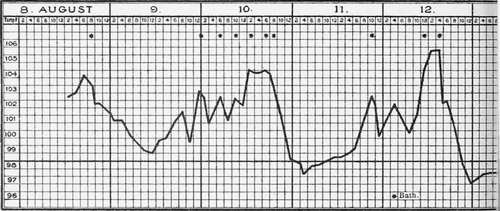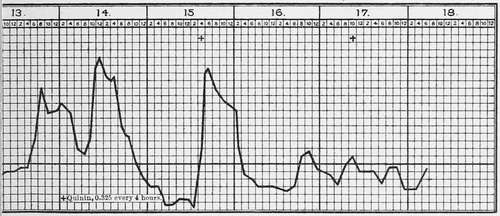Fevers Caused By Crescent-Forming Parasites
Description
This section is from the book "Malaria, Influenza And Dengue", by Julius Mennaberg and O. Leichtenstern. Also available from Amazon: Malaria, influenza and dengue.
Fevers Caused By Crescent-Forming Parasites
General Characteristics
The fevers belonging to this group are endemic in the severe malarial regions of the tropical and subtropical zone, and constitute there the predominant infection. Still there are not a few places in the temperate zone where they are endemic-for instance, the Roman Campagna, Sicily, Greece, Dalmatia, Croatia, etc. They occur here only at the height of summer and in autumn, and have been designated, therefore, by Italian writers, as "febbri estivo autunnali" (summer autumn fevers).
Moreover, they are not absolutely confined to the south. They have been repeatedly observed, even to an epidemic extent, in northern Europe. According to Hjelt, remittent fevers have been seen during isolated epidemics in Finland, up to latitude 61°. These occurred in August and were called August fever. They undoubtedly belong to this group. Similar fevers were observed in large numbers at the beginning of the seventy years' war in Wilhelmshaven. Isolated endemic foci are found in France, Holland, Hannover, and Holstein.
It is to these fevers that innumerable human lives have been sacrificed in tropical countries; it is these that present the greatest difficulties in the way of colonization by decimating the settlers. They have become, therefore, a great factor in national economy, with which the most powerful states have to reckon.
Having described the monotony of the clinical picture as the most striking peculiarity of the fevers under group I, we may say that the fevers of this group present a protean multiplicity of symptoms such as is seen in few infectious diseases.
Apart from the inevitable anemia, there is scarcely a second symptom which we can describe as of constant occurrence. The grouping of the various symptoms which may give rise to differential diagnostic difficulties with the most heterogeneous diseases- typhoid, cholera, yellow fever, psychoses, etc.-is more or less arbitrary.
The most important feature differentiating the fevers of this group from those of the first is their perniciousness. This does not insinuate that all the fevers caused by the small crescent forming parasite are pernicious in the sense that they show, without exception, symptoms dangerous to life, but only that they may show, and not infrequently do show, such symptoms, while the fevers of the first group scarcely ever become pernicious, even in this sense. It is, therefore, evident that the microscope may reveal not only the diagnosis, but also the prognosis and the therapy.

Fig. 28.-Remittent intermittent fever in ordinary

- tertian infection (after Thayer and Hewetson).
Moreover, a certain malignancy is attached even to these cases, which run their course without pernicious symptoms, inasmuch as in spite of energetic treatment with quinin they obstinately relapse and frequently produce severe anemia, cachexia, and other sequelae.
In a classification of these fevers it would be logical to divide them into two groups, corresponding to the parasites causing them, namely, quotidian and tertian. But this is not at the present time practical, since the characteristics of the parasites have not yet been sufficiently established to make them the basis of a rational diagnosis. Moreover, the multiple infections and mixed infections that occur so commonly, and the frequent differences in the periods of evolution of the parasites in different individuals, would make the matter so complicated that a division would be the cause of more confusion than elucidation. Finally, this division may be dispensed with, for the reason that the symptoms, both when caused by the quotidian parasites and the malignant tertian parasites, seem to be identical.
We will, therefore, avoid every fixed classification and endeavor to describe the complete symptom complex of these fevers in a general or detailed way, as may seem necessary.
Continue to:
- prev: Tertian Fever-Fever Caused By The Common Tertian Parasites
- Table of Contents
- next: Type Of Fever
Tags
mosquito, malaria, influenza, dengue, symptoms, outbreaks, diseases, hemoglobinuria, infections
